Joint Scheduling of New Energy Hybrid Tugboats and Berths Under Shore Power Constraint
Abstract
1. Introduction
- (1)
- A mixed-integer linear programming model for the joint scheduling of new energy hybrid tugboats and berths is established, breaking the traditional research boundaries that focus solely on conventional diesel tugboat.
- (2)
- A solution method combining the CPLEX solver with a heuristic-enhanced whale optimization algorithm is proposed for the established joint scheduling model of tugboats and berths. This method can obtain relatively accurate and feasible solutions in small-scale instances.
- (3)
- The impact of shore power facility constraint on hybrid tugboat scheduling is considered, specifically the limitations on tugboat charging periods due to a limited number of charging connectors. This analysis serves to enhance the practical applicability of the scheduling model.
2. Literature Review
2.1. Research on Tugboat Scheduling
2.2. Research on Berth Allocation
2.3. Integrated Tugboat–Berth Scheduling
2.4. Research on New Energy Hybrid Tugboat
3. Model
3.1. Problem Description
- (1)
- The term “empty sailing” is used to describe the movement of a tugboat from berth to anchorage. In the context of hybrid tugboats, the operation of battery-electric mode within the port area is a viable option.
- (2)
- Layby is defined as the period during which a tugboat is berthed. For hybrid tugboats, shore power can be utilized during layby to facilitate the charging of the battery pack and ensure the maintenance of endurance.
- (3)
- The term “tugging” refers to the process in which a tugboat provides assistance to a ship in either its berthing or unberthing maneuvers. Specifically, this can be subdivided into low-load and high-load phases.
3.2. Model Assumptions
3.3. Model Parameters and Variables
3.4. Scheduling Model
3.4.1. Objective Function
3.4.2. General Constraints for Tugboats
3.4.3. Operational Constraints for Hybrid Tugboats
3.4.4. Charging Constraints for Hybrid Tugboats
3.4.5. Ship-Related Constraints
3.4.6. Variable Non-Negativity Constraints
4. Methodology
4.1. Berth Allocation Solution
4.2. Solution Encoding
4.3. Tugboat Scheduling Solution
4.3.1. First Type of Crossing Method
4.3.2. Second Type of Crossing Method
4.3.3. Third Type of Crossing Method
4.3.4. Mutation Mechanism
4.3.5. Convergence Factor
4.4. Objective Function Value
- Step 1: Initialize I = 1. Proceed to Step 2.
- Step 2: If all ship berthing and unberthing tasks are completed (I > 2n), then end the process. Otherwise, find the task among all unsolved tasks that can start the earliest, designate this task as the current task, and mark its service sequence as I. (For ship requiring berthing, the earliest possible berthing time shall not be earlier than their arrival time and must maintain a safe time interval from the ship previously berthed at the same berth. If there is an unberthed ship occupying the planned berth, the incoming ship cannot commence berthing operations at that time. For ship scheduled to unberth, their earliest possible departure time corresponds to the completion time of berth operations.) Then proceed to Step 3.
- Step 3: The task’s start time is set to the earliest time at which the assigned tugboats can provide service. If a hybrid tugboat is included among the assigned tugboats, intermittent charging may be performed before the task’s start time. If the tugboat is waiting at the anchorage and the current task is a berthing task, the tugboat will not return to the berth for charging.
- The first rule is that tugboats with earlier task sequences are given priority to use the earliest available charging connectors. Therefore, the operation sequence encoding also determines the priority of the tugboats using the charging connectors. For example, in Figure 7, tugboats 1 and 2, which perform berthing operations for ship 1, are scheduled to charge before tugboats 3 and 5, which perform berthing operations for ship 2.
- The second rule is that a tugboat in the first layer of the tugboat encoding is given higher charging priority than one in the second layer. For example, tugboat 1, which performs the berthing operation for ship 1, is scheduled to charge before tugboat 2.
- The third rule stipulates that a tugboat occupying a charging connector will continue charging until reaching the maximum feasible state of charge, or a level sufficient for use within the scheduling horizon, before disconnecting from the connector.
4.5. Initial Solution
5. Case Study Analysis
5.1. Model and Algorithm Validation
5.2. Solution Result Analysis
5.3. Sensitivity Analysis
6. Conclusions
- (1)
- The joint scheduling MILP model developed is effective. For small-scale examples, the algorithm in this paper can generate feasible scheduling solutions that are close to the exact solution in a short time. Furthermore, the utilization of a heuristic initial solution strategy has been demonstrated to have a substantial impact on the algorithm’s search efficiency.
- (2)
- The number of charging connectors for hybrid tugboats has a significant impact on the total scheduling cost. In scenarios where the number of charging connectors is limited, it becomes challenging to achieve a reduction in the overall scheduling cost. The required number of charging connectors should be determined according to the scheduling requirements of hybrid tugboats.
- (3)
- The appropriate values for the number of charging connectors, battery capacity, and charging rate for hybrid tugboats significantly affect the total scheduling cost. When battery capacity and charging rate values are appropriately selected, configuring a number of charging connectors different from the number of hybrid tugboats can still effectively reduce the tugboat operational costs. Consequently, the port authority can reduce the number of tugboat charging facilities to a certain extent.
Author Contributions
Funding
Data Availability Statement
Conflicts of Interest
References
- Iris, Ç.; Lam, J.S.L. A Review of Energy Efficiency in Ports: Operational Strategies, Technologies and Energy Management Systems. Renew. Sustain. Energy Rev. 2019, 112, 170–182. [Google Scholar] [CrossRef]
- Wang, S.; Kaku, I.; Chen, G.Y.; Zhu, M. Research on the Modeling of Tugboat Assignment Problem in Container Terminal. Adv. Mater. Res. 2012, 433–440, 1957–1961. [Google Scholar] [CrossRef]
- Wang, S.; Zhu, M.; Kaku, I.; Chen, G.; Wang, M. An Improved Discrete PSO for Tugboat Assignment Problem under a Hybrid Scheduling Rule in Container Terminal. Math. Probl. Eng. 2014, 2014, 714832. [Google Scholar] [CrossRef]
- Kang, L.; Meng, Q.; Tan, K.C. Tugboat Scheduling under Ship Arrival and Tugging Process Time Uncertainty. Transp. Res. Part E Logist. Transp. Rev. 2020, 144, 102125. [Google Scholar] [CrossRef]
- Hao, L.; Jin, J.G.; Zhao, K. Joint Scheduling of Barges and Tugboats for River–Sea Intermodal Transport. Transp. Res. Part E Logist. Transp. Rev. 2023, 173, 103097. [Google Scholar] [CrossRef]
- Xu, Q.; Mao, J.; Jin, Z. Simulated Annealing-Based Ant Colony Algorithm for Tugboat Scheduling Optimization. Math. Probl. Eng. 2012, 2012, 246978. [Google Scholar] [CrossRef]
- Zhen, L.; Wang, K.; Wang, S.; Qu, X. Tug Scheduling for Hinterland Barge Transport: A Branch-and-Price Approach. Eur. J. Oper. Res. 2018, 265, 119–132. [Google Scholar] [CrossRef]
- Wei, X.; Jia, S.; Meng, Q.; Tan, K.C. Tugboat Scheduling for Container Ports. Transp. Res. Part E Logist. Transp. Rev. 2020, 142, 102071. [Google Scholar] [CrossRef]
- Jia, S.; Li, S.; Lin, X.; Chen, X. Scheduling Tugboats in a Seaport. Transp. Sci. 2021, 55, 1370–1391. [Google Scholar] [CrossRef]
- Zhu, S.; Gao, J.; He, X.; Zhang, S.; Jin, Y.; Tan, Z. Green Logistics Oriented Tug Scheduling for Inland Waterway Logistics. Adv. Eng. Inform. 2021, 49, 101323. [Google Scholar] [CrossRef]
- Zhong, H.; Zhang, Y.; Gu, Y. A Bi-Objective Green Tugboat Scheduling Problem with the Tidal Port Time Windows. Transp. Res. Part Transp. Environ. 2022, 110, 103409. [Google Scholar] [CrossRef]
- Li, B.; Chen, Q.; Lau, Y.; Dulebenets, M.A. Tugboat Scheduling with Multiple Berthing Bases under Uncertainty. J. Mar. Sci. Eng. 2023, 11, 2180. [Google Scholar] [CrossRef]
- Wang, X.; Liang, Y.; Wei, X.; Chew, E.P. An Adaptive Large Neighborhood Search Algorithm for the Tugboat Scheduling Problem. Comput. Ind. Eng. 2023, 177, 109039. [Google Scholar] [CrossRef]
- Sun, C.; Li, M.; Chen, L.; Chen, P. Dynamic Tugboat Scheduling for Large Seaports with Multiple Terminals. J. Mar. Sci. Eng. 2024, 12, 170. [Google Scholar] [CrossRef]
- Imai, A.; Nishimura, E.; Papadimitriou, S. The Dynamic Berth Allocation Problem for a Container Port. Transp. Res. Part B Methodol. 2001, 35, 401–417. [Google Scholar] [CrossRef]
- Prencipe, L.P.; Marinelli, M. A Novel Mathematical Formulation for Solving the Dynamic and Discrete Berth Allocation Problem by Using the Bee Colony Optimisation Algorithm. Appl. Intell. 2021, 51, 4127–4142. [Google Scholar] [CrossRef]
- Umang, N.; Bierlaire, M.; Vacca, I. Exact and Heuristic Methods to Solve the Berth Allocation Problem in Bulk Ports. Transp. Res. Part E Logist. Transp. Rev. 2013, 54, 14–31. [Google Scholar] [CrossRef]
- Kordić, S.; Davidović, T.; Kovač, N.; Dragović, B. Combinatorial Approach to Exactly Solving Discrete and Hybrid Berth Allocation Problem. Appl. Math. Model. 2016, 40, 8952–8973. [Google Scholar] [CrossRef]
- Ernst, A.T.; Oğuz, C.; Singh, G.; Taherkhani, G. Mathematical Models for the Berth Allocation Problem in Dry Bulk Terminals. J. Sched. 2017, 20, 459–473. [Google Scholar] [CrossRef]
- Venturini, G.; Iris, Ç.; Kontovas, C.A.; Larsen, A. The Multi-Port Berth Allocation Problem with Speed Optimization and Emission Considerations. Transp. Res. Part Transp. Environ. 2017, 54, 142–159. [Google Scholar] [CrossRef]
- Cheimanoff, N.; Fontane, F.; Kitri, M.N.; Tchernev, N. A Reduced VNS Based Approach for the Dynamic Continuous Berth Allocation Problem in Bulk Terminals with Tidal Constraints. Expert Syst. Appl. 2021, 168, 114215. [Google Scholar] [CrossRef]
- Martin-Iradi, B.; Pacino, D.; Ropke, S. An Adaptive Large Neighborhood Search Heuristic for the Multi-Port Continuous Berth Allocation Problem. Eur. J. Oper. Res. 2024, 316, 152–167. [Google Scholar] [CrossRef]
- Iris, Ç.; Lam, J.S.L. Recoverable Robustness in Weekly Berth and Quay Crane Planning. Transp. Res. Part B Methodol. 2019, 122, 365–389. [Google Scholar] [CrossRef]
- Yang, Z.-Y.; Cao, X.; Xu, R.-Z.; Hong, W.-C.; Sun, S.-L. Applications of Chaotic Quantum Adaptive Satin Bower Bird Optimizer Algorithm in Berth-Tugboat-Quay Crane Allocation Optimization. Expert Syst. Appl. 2024, 237, 121471. [Google Scholar] [CrossRef]
- Chu, L.; Zhang, J.; Chen, X.; Yu, Q. Optimization of Integrated Tugboat–Berth–Quay Crane Scheduling in Container Ports Considering Uncertainty in Vessel Arrival Times and Berthing Preferences. J. Mar. Sci. Eng. 2024, 12, 1541. [Google Scholar] [CrossRef]
- Wang, Y.; Zou, T. Optimization of Berth-Tug Co-Scheduling in Container Terminals under Dual-Carbon Contexts. J. Mar. Sci. Eng. 2024, 12, 684. [Google Scholar] [CrossRef]
- Fan, H.; Zhang, T.-H.; Zhao, J.; Yue, L.-J. Berth Allocation and Tugboat Scheduling Problem for Tidal Ports with Compound Channels: The Case of Tianjin Port. Ocean Eng. 2025, 324, 120744. [Google Scholar] [CrossRef]
- Kumar, B.A.; Selvaraj, R.; Desingu, K.; Chelliah, T.R.; Upadhyayula, R.S. A Coordinated Control Strategy for a Diesel-Electric Tugboat System for Improved Fuel Economy. IEEE Trans. Ind. Appl. 2020, 56, 5439–5451. [Google Scholar] [CrossRef]
- Karaçay, Ö.E.; Özsoysal, O.A. Techno-Economic Investigation of Alternative Propulsion Systems for Tugboats. Energy Convers. Manag. X 2021, 12, 100140. [Google Scholar] [CrossRef]
- Devarapali, S.; Manske, A.; Khayamim, R.; Jacobs, E.; Li, B.; Elmi, Z.; Dulebenets, M.A. Electric Tugboat Deployment in Maritime Transportation: Detailed Analysis of Advantages and Disadvantages. Marit. Bus. Rev. 2024, 9, 263–291. [Google Scholar] [CrossRef]
- Chen, Y.-S.; Chang, T.-L.; Tsai, M.-C. Research on Adoption of Hybrid Electric Tugboats for Achieving Carbon Reduction Emissions in Taiwan. Mar. Pollut. Bull. 2025, 217, 118081. [Google Scholar] [CrossRef]
- Iris, Ç.; Lam, J.S.L. Optimal Energy Management and Operations Planning in Seaports with Smart Grid While Harnessing Renewable Energy under Uncertainty. Omega 2021, 103, 102445. [Google Scholar] [CrossRef]
- Zhang, Z.; Zhu, Y.; Zhu, J.; Huang, D.; Yin, C.; Li, J. Collaborative Optimization of Shore Power and Berth Allocation Based on Economic, Environmental, and Operational Efficiency. J. Mar. Sci. Eng. 2025, 13, 776. [Google Scholar] [CrossRef]
- Mirjalili, S.; Lewis, A. The Whale Optimization Algorithm. Adv. Eng. Softw. 2016, 95, 51–67. [Google Scholar] [CrossRef]
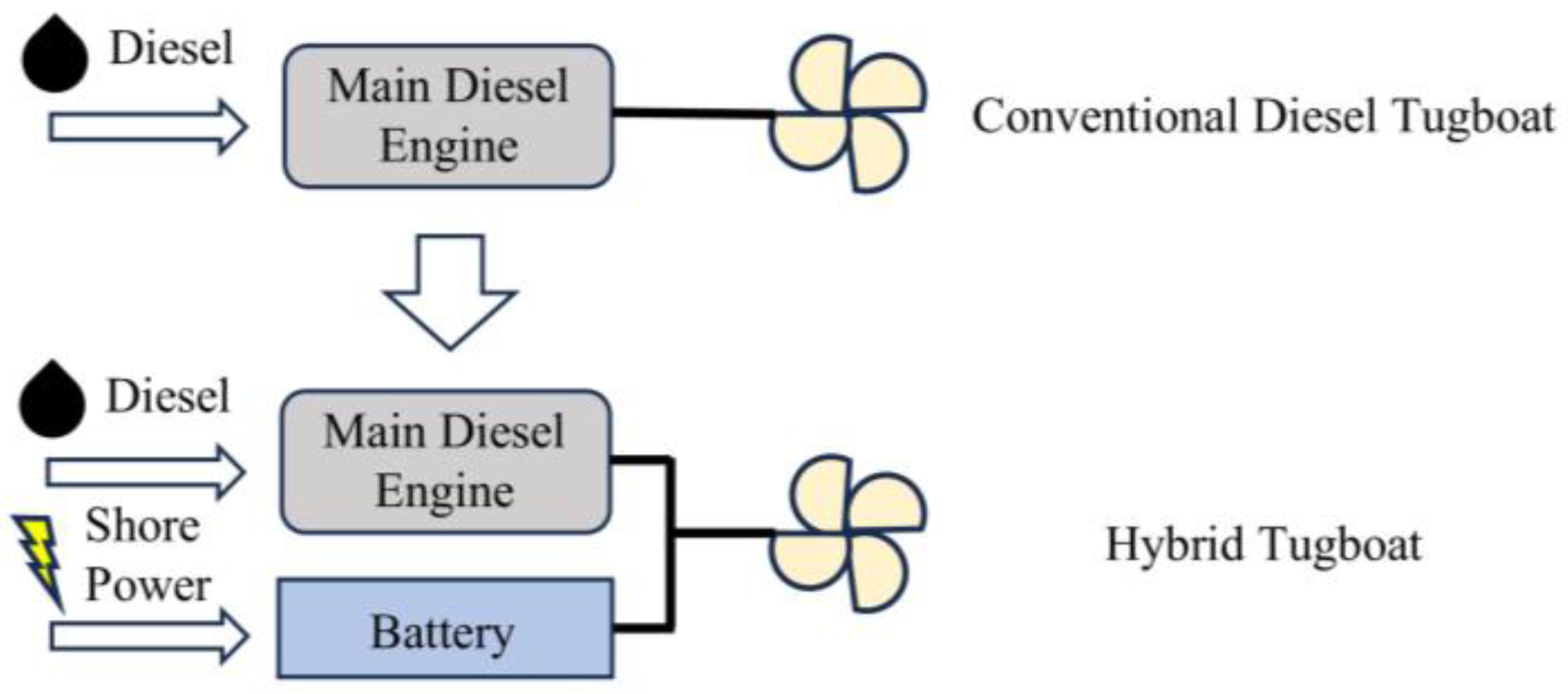
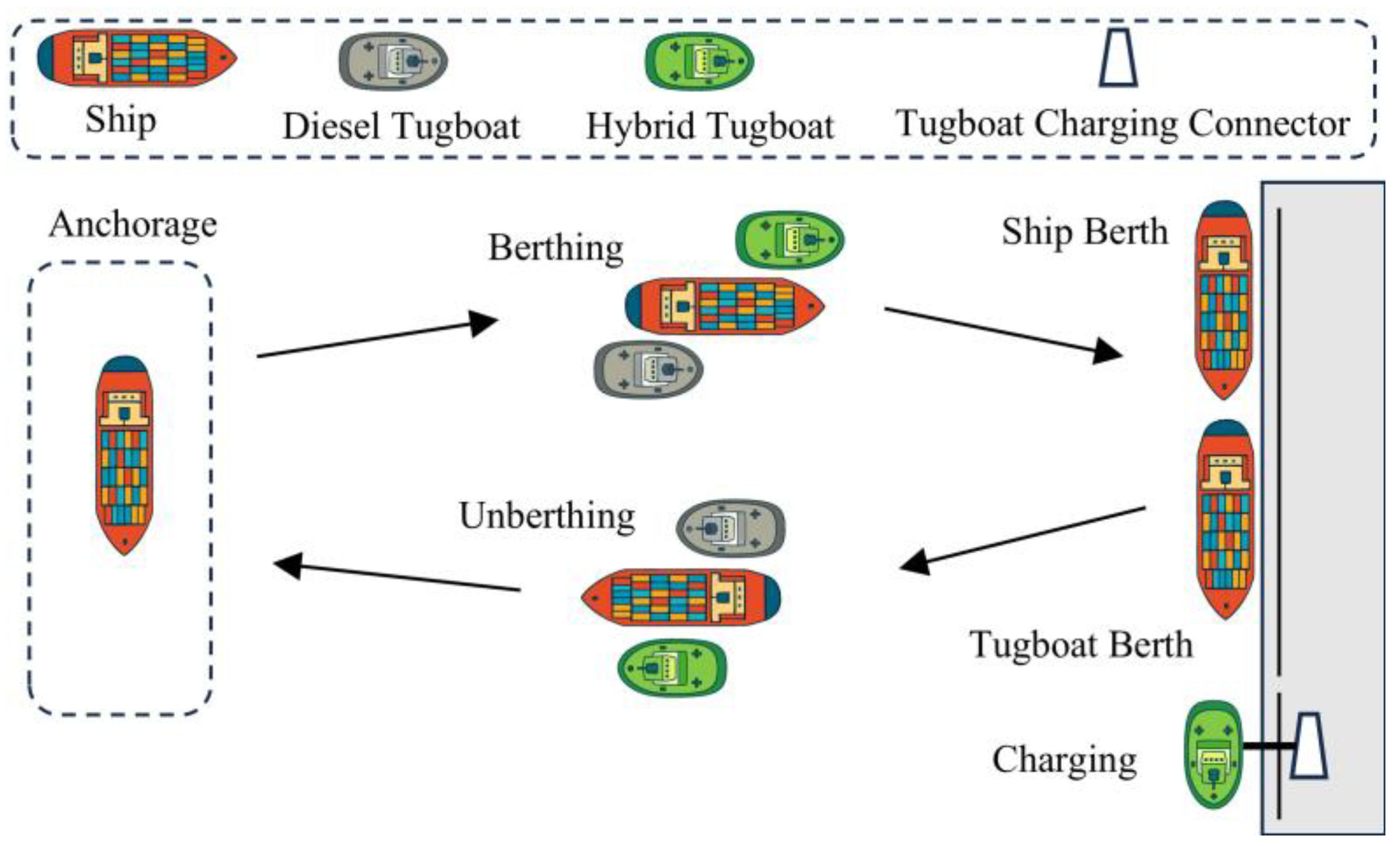
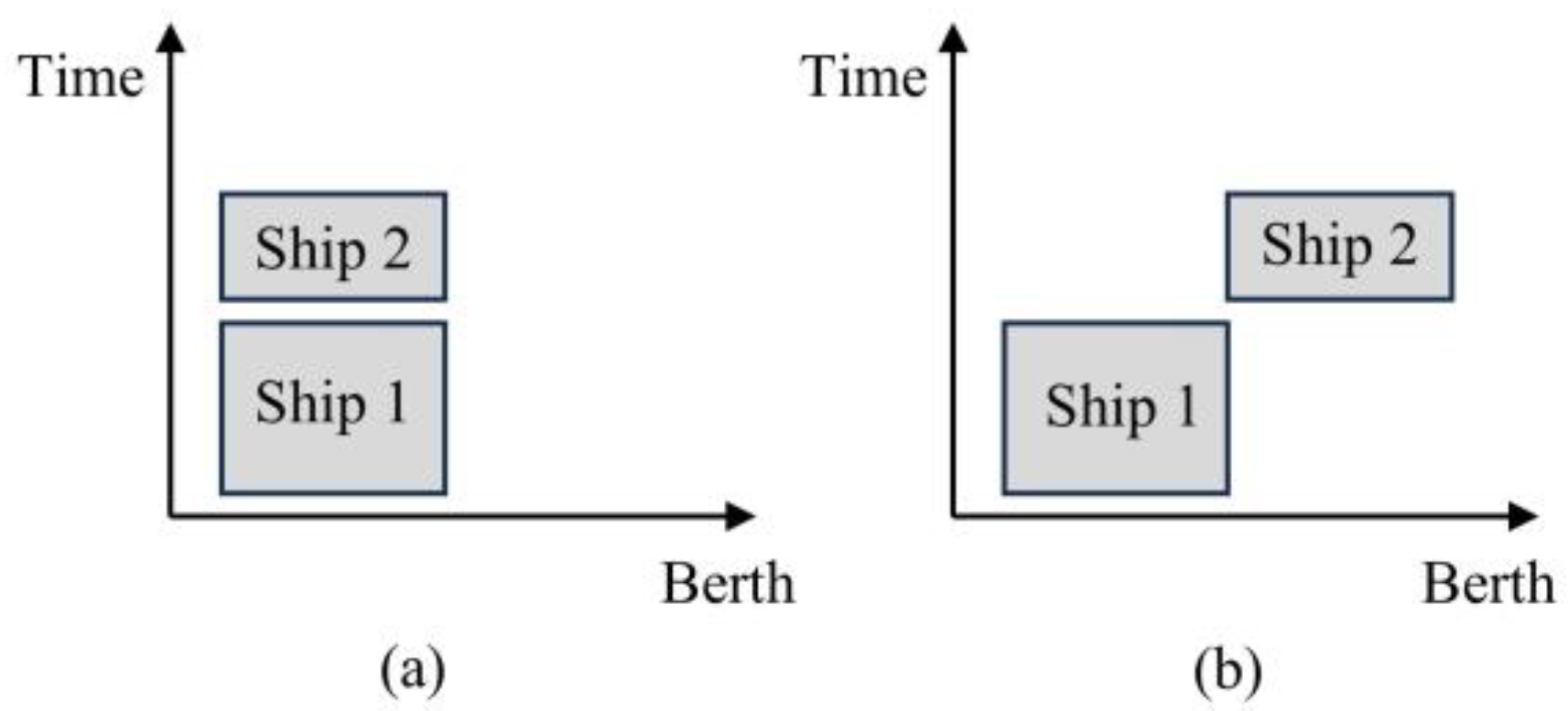
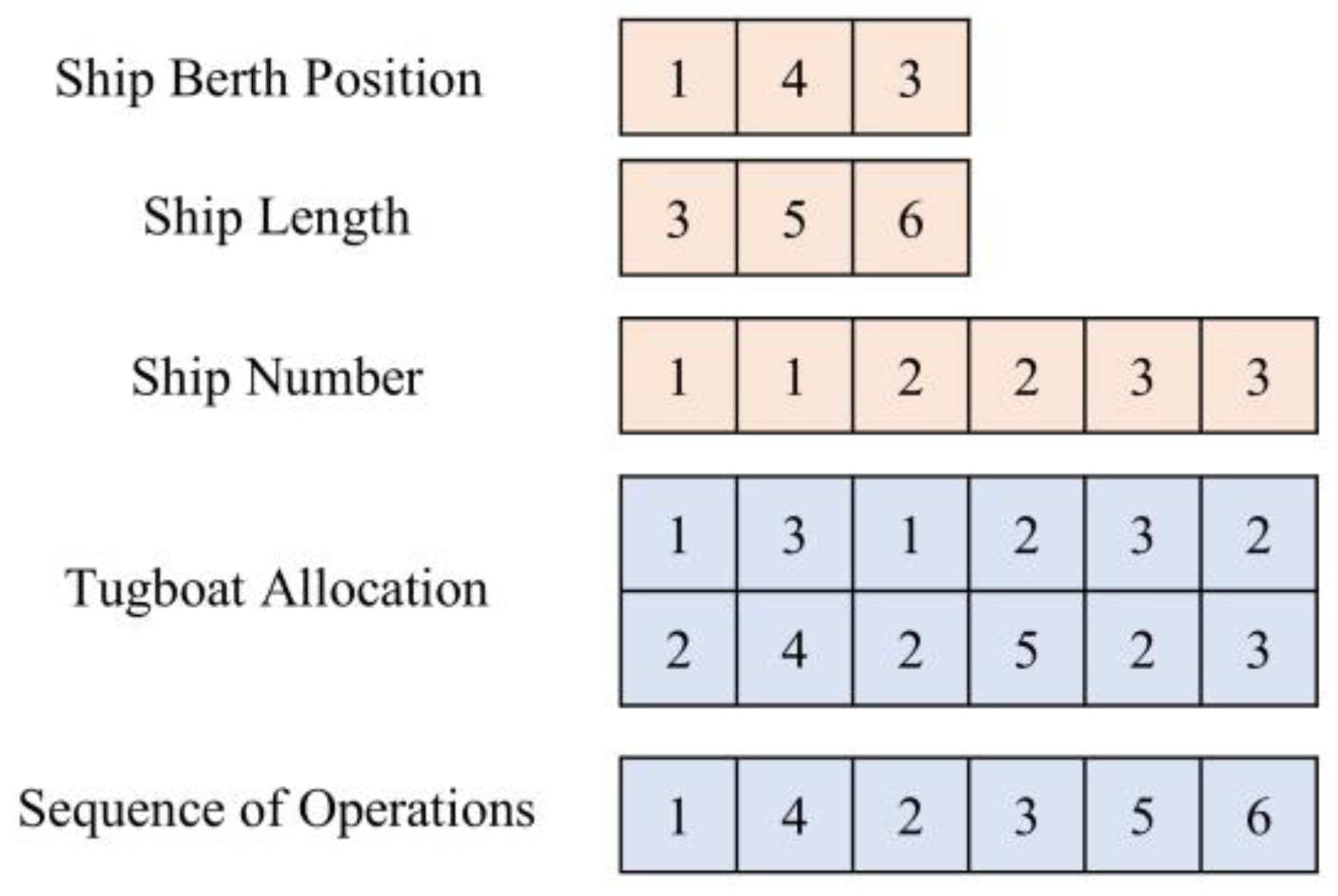
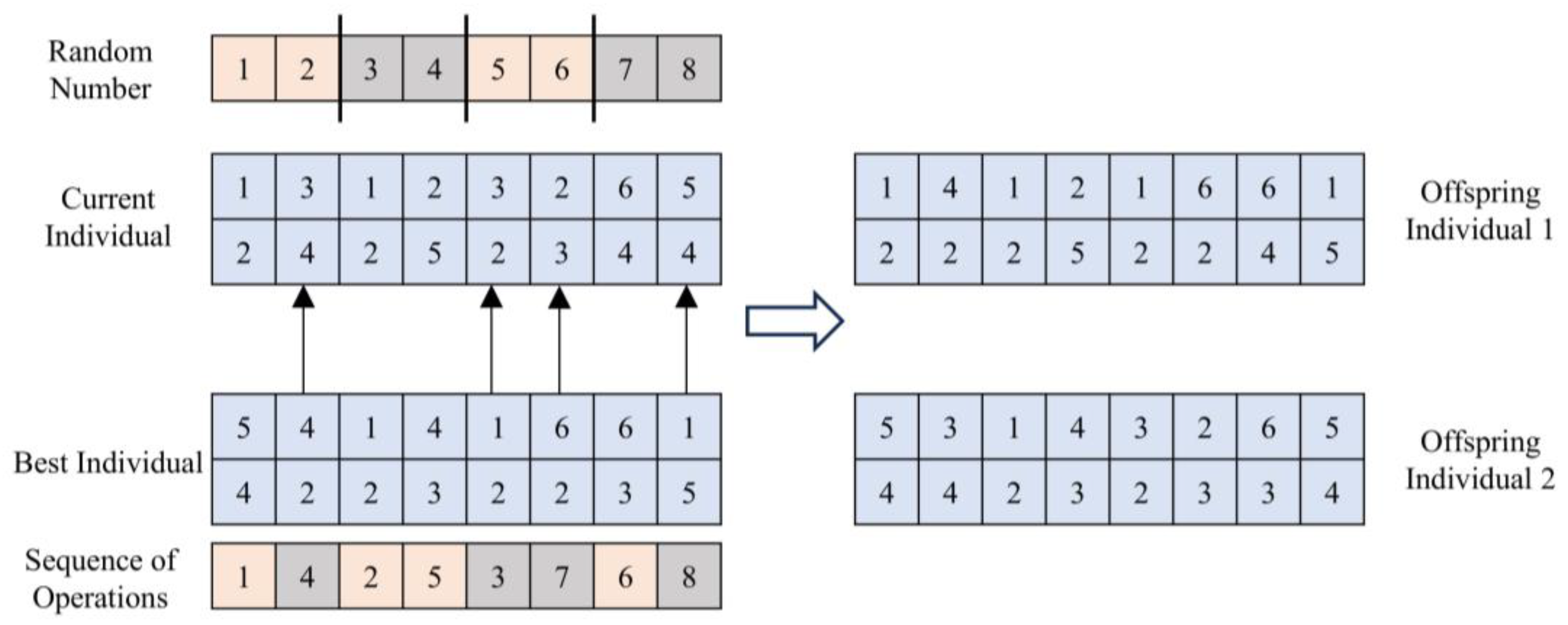
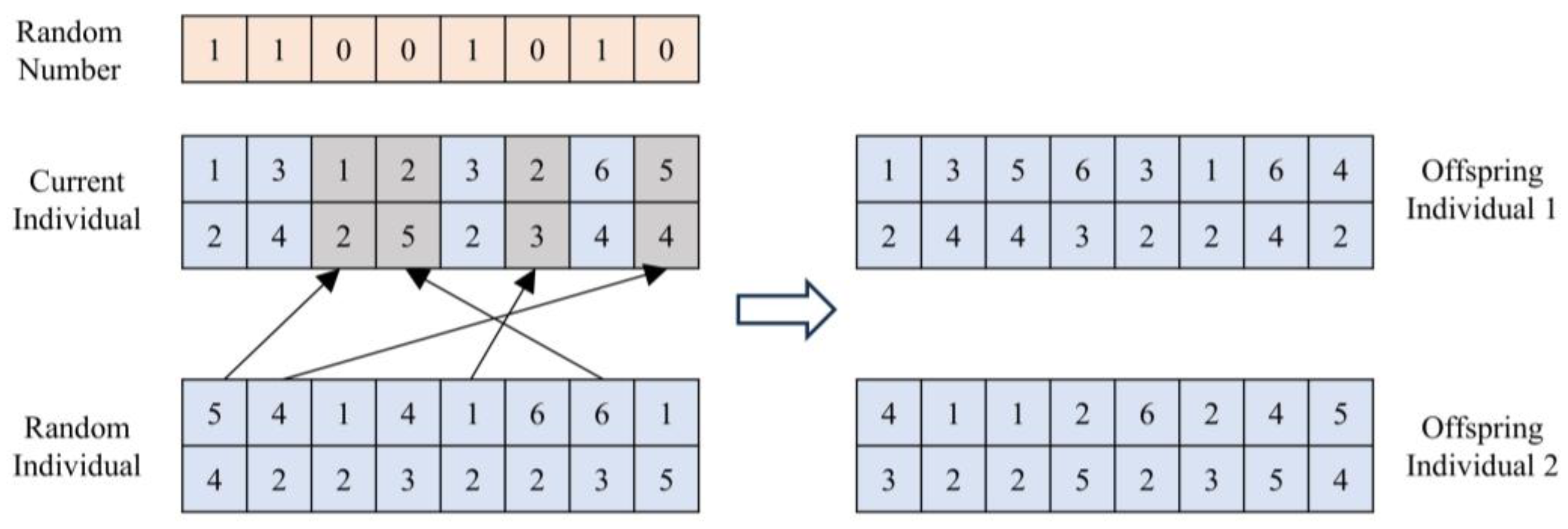

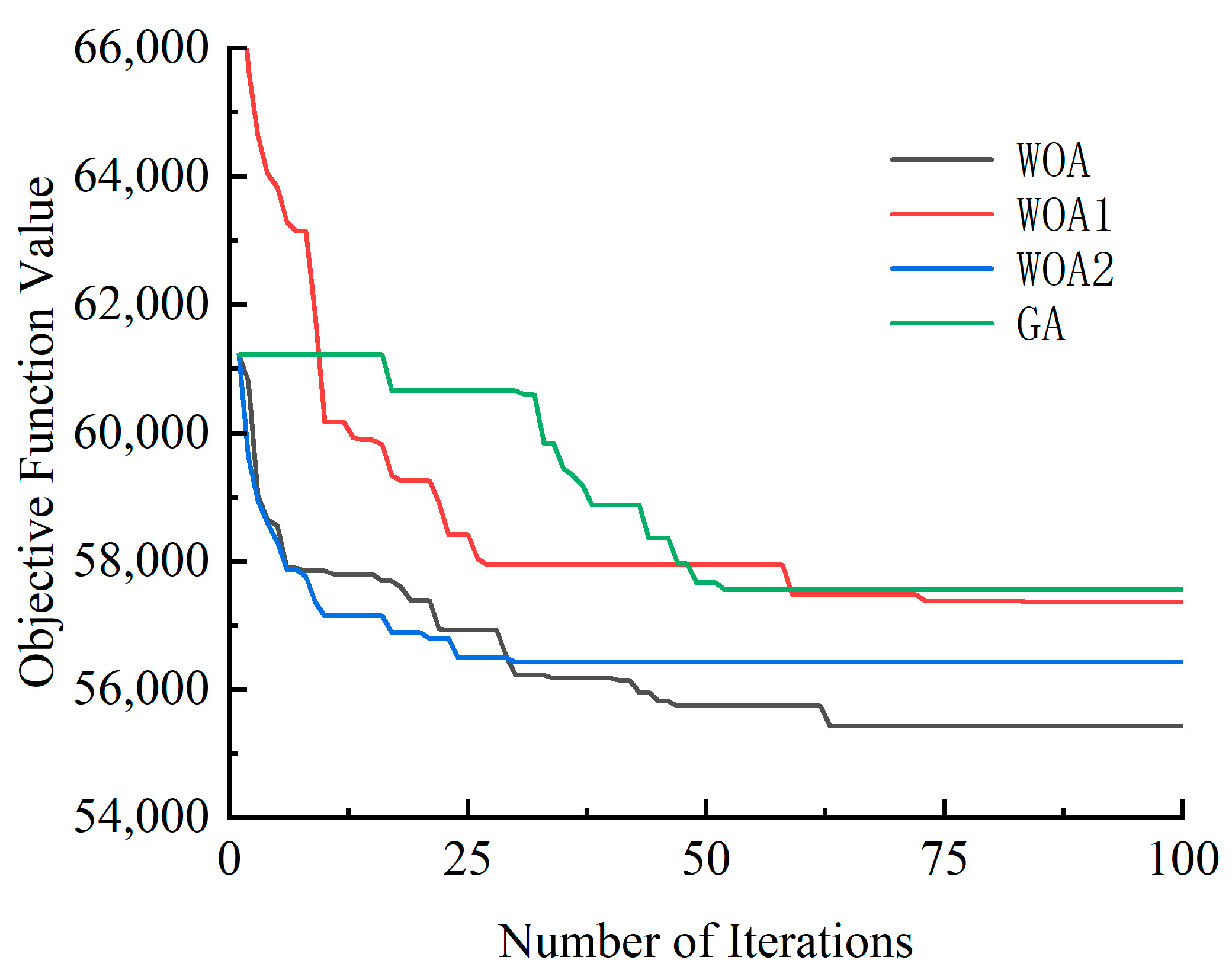
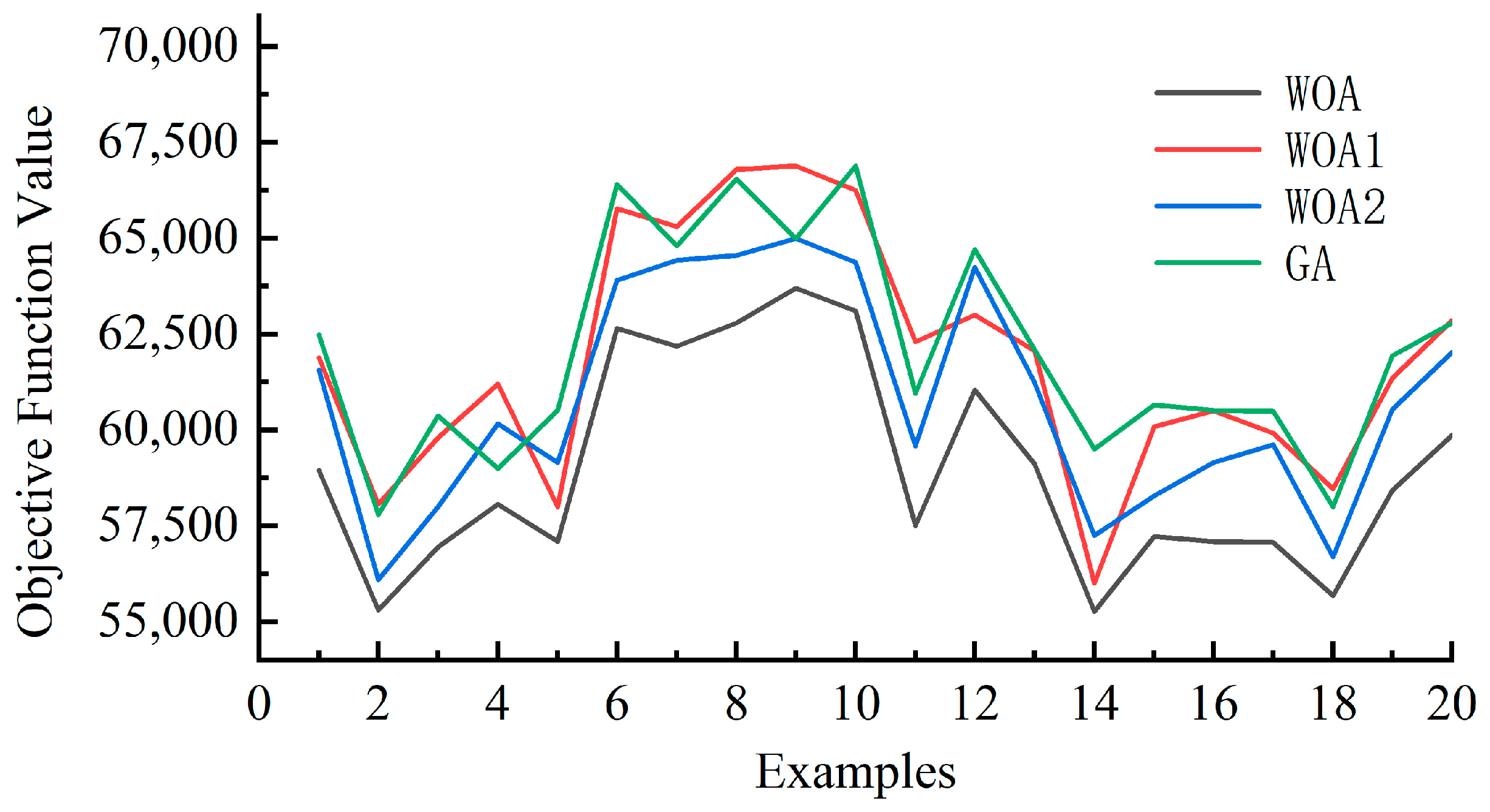

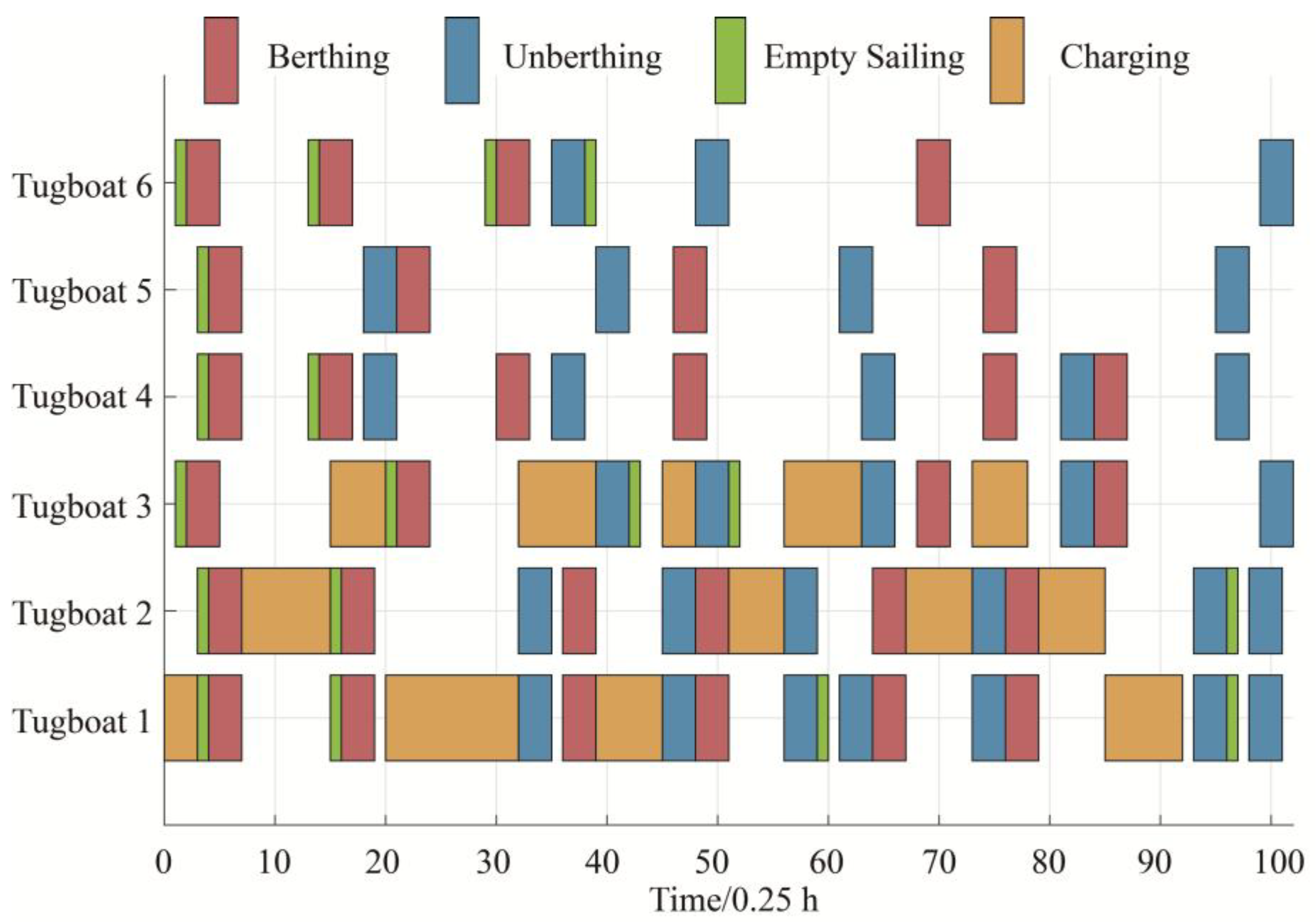

| Reference | Conditions | Tugboat | Berth | Model | Method |
|---|---|---|---|---|---|
| Wang et al. [26] | Shore power connection for ships | Conventional diesel tugboat | Continuous | Two-layer mixed-integer linear programming | CPLEX + IAPSO |
| Fan et al. [27] | Tidal time window | Conventional diesel tugboat | Continuous | Two-layer mixed-integer linear programming | Enumeration + GNVAS |
| This paper | Limitations of tugboat charging facilities | Conventional diesel tugboat + Hybrid tugboat | Continuous | Mixed-integer linear programming | CPLEX + WOA |
| Notation | Sets |
|---|---|
| N | Set of incoming ships, N = {1, 2, …, n} |
| M | Set of tugboats, M = {1, 2, …, |M|} |
| MC | Set of diesel tugboats |
| MX | Set of hybrid tugboats |
| K | Set of tugboat task sequences, K = {1, 2, …, 2n} |
| J | Set of ship task stages, J = {1, 2} |
| T | Set of time periods, T = {1, 2, …} |
| i | Ship index |
| k | Task sequence index |
| t | Time period index |
| m | Tugboat index |
| Si | Number of tugboats required for ship i |
| Ai | Arrival time of ship i |
| Hi | Operation time of ship i |
| DAi | Latest departure time of ship i |
| Li | Length of ship i |
| LH | Total berth length |
| Rm | Power class of tugboat m |
| Gi | Required tugboat power level for ship i |
| GP | Safe time interval between berthing and unberthing of ships at the same berth |
| TH | Empty sailing time of tugboats between anchorage and berth |
| TZ | Time required for tugboat assistance operation |
| EKm | Empty sailing energy consumption of tugboat m |
| EDm | Energy consumption of tugboat m under low-load phases during tugging |
| EZi | Energy consumption of tugboat during tugging for ship i under high-load phases |
| EL | Battery capacity of hybrid tugboats |
| EC | Initial state of charge of hybrid tugboats |
| U | Charging rate of tugboats per time unit |
| RE | Preparation time required for tugboat charging |
| C1 | Ship waiting cost per time unit |
| C2 | Ship delay departure cost per time unit |
| C3 | Diesel cost corresponding to the energy consumption per unit of tugboat operation |
| C4 | Electricity cost corresponding to the energy consumption per unit of tugboat operation |
| NU | Number of tugboat charging connectors |
| E | A sufficiently large number |
| Notation | Sets |
|---|---|
| Xi,j,m,k | Xi,j,m,k = 1 if the j-th stage of ship i is the k-th task of tugboat m, otherwise Xi,j,m,k = 0 |
| Yi,i′ | Yi,i′ = 1 if ship i′ berths later than ship i depart, otherwise Yi,i′ = 0 |
| Pi | Berthing position of ship i |
| Zi,i′ | Zi,i′ = 1 if ship i is completely berthed to the left of ship i′, otherwise Zi,i′ = 0 |
| Qi | Delayed departure time of ship i |
| STi,j | Start time of the j-th operation stage of ship i |
| DEm,k | State of charge of tugboat m before completing the k-th task |
| HDm,k | Electric energy consumed by tugboat m for completing the k-th task |
| ENm,k | Energy consumption under low-load conditions of tugboat m for completing the k-th Task |
| Vm,k | Vm,k = 1 if tugboat m charges before completing the k-th task, otherwise Vm,k = 0 |
| CVm,k,t | CVm,k,t = 1 if tugboat m charges at period t before completing the k-th task, otherwise CVm,k,t = 0 |
| CSm,k | Charging start time of tugboat m before completing the k-th task |
| CEm,k | Charging end time of tugboat m before completing the k-th task |
| Tugboat Number | Tugboat Power Class | Tugboat Characteristics | Empty Sailing Energy Consumption (30 kWh/6 kg) | Energy Consumption Under Low-Load Phase During Tugging (30 kWh/6 kg) |
|---|---|---|---|---|
| 1 | 3 | Hybrid Tugboat | 8 | 8 |
| 2 | 3 | Hybrid Tugboat | 8 | 8 |
| 3 | 3 | Hybrid Tugboat | 8 | 8 |
| 4 | 2 | Diesel Tugboat | 7 | 7 |
| 5 | 2 | Diesel Tugboat | 7 | 7 |
| 6 | 1 | Diesel Tugboat | 6 | 6 |
| Ship Number | Length (50 m) | Ship Type | Arrival Time (0.25 h) | Operation Time (0.25 h) | Latest Departure Time (0.25 h) |
|---|---|---|---|---|---|
| 1 | 3 | Small | 2 | 30 | 40 |
| 2 | 6 | Large | 4 | 25 | 36 |
| 3 | 5 | Medium | 4 | 11 | 32 |
| 4 | 3 | Small | 14 | 22 | 56 |
| 5 | 6 | Large | 16 | 26 | 55 |
| 6 | 5 | Medium | 20 | 32 | 65 |
| 7 | 4 | Small | 28 | 26 | 58 |
| 8 | 5 | Medium | 36 | 24 | 72 |
| 9 | 6 | Large | 44 | 22 | 70 |
| 10 | 5 | Medium | 46 | 12 | 86 |
| 11 | 5 | Medium | 64 | 14 | 96 |
| 12 | 4 | Small | 68 | 27 | 105 |
| 13 | 7 | Large | 72 | 14 | 107 |
| 14 | 5 | Medium | 74 | 18 | 110 |
| 15 | 4 | Small | 76 | 12 | 110 |
| Parameter | Value |
|---|---|
| C1 | 200 |
| C2 | 200 |
| C3 | 48 |
| C4 | 30 |
| NU | 1 |
| RE | 2 |
| U | 5 |
| EL | 50 |
| EC | 20 |
| TH | 1 |
| TZ | 3 |
| Number of Ships | Number of Hybrid Tugboats | Number of Charging Connectors | CPLEX | CPLEX + WOA | |||
|---|---|---|---|---|---|---|---|
| OBJ | CT (s) | OBJ | CT (s) | GAP (%) | |||
| 5 | 2 | 1 | 19,048 | 705 | 19,326 | 491 | 1.46 |
| 5 | 3 | 1 | 18,616 | 900 | 18,894 | 489 | 1.49 |
| 5 | 3 | 2 | 18,520 | 706 | 18,576 | 493 | 0.30 |
| 5 | 4 | 1 | 18,118 | 1087 | 18,360 | 496 | 1.34 |
| 5 | 4 | 2 | 17,922 | 658 | 18,054 | 494 | 0.74 |
| 5 | 5 | 1 | 17,638 | 1212 | 17,910 | 494 | 1.54 |
| 5 | 5 | 2 | 17,484 | 1002 | 17,616 | 496 | 0.75 |
| 6 | 2 | 1 | 22,604 | 12,212 | 22,760 | 518 | 0.70 |
| 6 | 3 | 1 | 22,040 | 13,200 | 22,190 | 520 | 0.68 |
| 6 | 3 | 2 | 21,848 | 12,010 | 21,884 | 518 | 0.16 |
| 6 | 4 | 1 | 21,272 | 19,258 | 21,380 | 518 | 0.51 |
| 6 | 4 | 2 | 21,038 | 14,021 | 21,110 | 518 | 0.34 |
| 6 | 5 | 1 | 20,738 | 21,589 | 20,882 | 520 | 0.69 |
| 6 | 5 | 2 | 20,456 | 15,265 | 20,576 | 519 | 0.59 |
| Example Number | N = 5 | N = 6 | ||||
|---|---|---|---|---|---|---|
| CPLEX | CPLEX + WOA | CPLEX | CPLEX + WOA | |||
| OBJ | OBJ | GAP (%) | OBJ | OBJ | GAP (%) | |
| 1 | 16,884 | 17,040 | 0.92 | 19,974 | 20,148 | 0.87 |
| 2 | 19,384 | 19,576 | 0.99 | 22,176 | 22,368 | 0.87 |
| 3 | 16,806 | 17,070 | 1.57 | 20,098 | 20,350 | 1.25 |
| 4 | 16,724 | 17,076 | 2.10 | 19,952 | 20,208 | 1.28 |
| 5 | 15,984 | 16,092 | 0.68 | 19,932 | 20,016 | 0.42 |
| 6 | 16,944 | 17,136 | 1.13 | 19,824 | 20,016 | 0.97 |
| 7 | 16,482 | 16,536 | 0.33 | 20,560 | 20,608 | 0.23 |
| 8 | 17,304 | 17,496 | 1.11 | 20,412 | 20,604 | 0.94 |
| 9 | 18,976 | 19,120 | 0.76 | 21,872 | 21,926 | 0.25 |
| 10 | 18,618 | 18,888 | 1.49 | 22,718 | 22,952 | 1.03 |
| 11 | 16,848 | 16,848 | 0.00 | 19,920 | 19,956 | 0.18 |
| 12 | 19,384 | 19,438 | 0.23 | 22,176 | 22,176 | 0.00 |
| 13 | 16,752 | 16,752 | 0.00 | 20,032 | 20,128 | 0.48 |
| 14 | 16,688 | 16,944 | 1.53 | 19,760 | 20,016 | 1.30 |
| 15 | 15,984 | 16,086 | 0.64 | 19,864 | 20,016 | 0.77 |
| 16 | 16,944 | 16,944 | 0.00 | 19,824 | 19,824 | 0.00 |
| 17 | 16,392 | 16,392 | 0.00 | 20,416 | 20,416 | 0.00 |
| 18 | 17,304 | 17,304 | 0.00 | 20,376 | 20,376 | 0.00 |
| 19 | 18,976 | 18,976 | 0.00 | 21,872 | 21,872 | 0.00 |
| 20 | 18,618 | 18,792 | 0.93 | 22,682 | 22,808 | 0.56 |
| Mutation Probability | Population Size | Best Obtained OBJ | Average OBJ | Average CT |
|---|---|---|---|---|
| 0.1 | 30 | 56,414 | 57,345 | 602 |
| 40 | 56,208 | 57,032 | 793 | |
| 50 | 55,954 | 56,692 | 984 | |
| 60 | 55,870 | 56,601 | 1184 | |
| 0.2 | 30 | 56,446 | 57,200 | 602 |
| 40 | 56,056 | 56,902 | 794 | |
| 50 | 55,424 | 56,406 | 986 | |
| 60 | 55,424 | 56,405 | 1193 | |
| 0.3 | 30 | 56,528 | 57,210 | 602 |
| 40 | 56,080 | 56,912 | 795 | |
| 50 | 55,870 | 56,502 | 986 | |
| 60 | 55,582 | 56,498 | 1194 |
| Ship Number | Berthing Position (50 m) | Berthing Start Time (0.25 h) | Berthing Tugboat Number | Berthing Scheduling Sequence | Unberthing Start Time (0.25 h) | Unberthing Tugboat Number | Unberthing Scheduling Sequence |
|---|---|---|---|---|---|---|---|
| 1 | 20 | 2 | 3, 6 | 1 | 35 | 6, 4 | 10 |
| 2 | 14 | 4 | 1, 2 | 2 | 32 | 1, 2 | 8 |
| 3 | 9 | 4 | 4, 5 | 3 | 18 | 4, 5 | 6 |
| 4 | 6 | 14 | 6, 4 | 4 | 39 | 3, 5 | 12 |
| 5 | 0 | 16 | 2, 1 | 5 | 45 | 1, 2 | 13 |
| 6 | 9 | 21 | 5, 3 | 7 | 56 | 2, 1 | 17 |
| 7 | 14 | 30 | 6, 4 | 9 | 48 | 6, 3 | 15 |
| 8 | 18 | 36 | 1, 2 | 11 | 63 | 3, 4 | 19 |
| 9 | 0 | 48 | 1, 2 | 14 | 73 | 2, 1 | 22 |
| 10 | 14 | 46 | 4, 5 | 16 | 61 | 5, 1 | 18 |
| 11 | 14 | 64 | 2, 1 | 20 | 81 | 4, 3 | 25 |
| 12 | 7 | 68 | 3, 6 | 21 | 98 | 2, 1 | 29 |
| 13 | 0 | 76 | 1, 2 | 23 | 93 | 2, 1 | 27 |
| 14 | 19 | 74 | 4, 5 | 24 | 95 | 4, 5 | 28 |
| 15 | 11 | 84 | 3, 4 | 26 | 99 | 6, 3 | 30 |
| Number of Charging Connectors | Total Scheduling Cost | Total Diesel Consumption of Tugboats (6 kg) | Total Electricity Consumption of Tugboats (30 kWh) |
|---|---|---|---|
| 1 | 55,424 | 848 | 324 |
| 2 | 54,484 | 798 | 406 |
| 3 | 54,352 | 794 | 408 |
Disclaimer/Publisher’s Note: The statements, opinions and data contained in all publications are solely those of the individual author(s) and contributor(s) and not of MDPI and/or the editor(s). MDPI and/or the editor(s) disclaim responsibility for any injury to people or property resulting from any ideas, methods, instructions or products referred to in the content. |
© 2025 by the authors. Licensee MDPI, Basel, Switzerland. This article is an open access article distributed under the terms and conditions of the Creative Commons Attribution (CC BY) license (https://creativecommons.org/licenses/by/4.0/).
Share and Cite
Chu, L.; Lin, J.; Xu, X.; Yang, Z.; Yang, Q. Joint Scheduling of New Energy Hybrid Tugboats and Berths Under Shore Power Constraint. J. Mar. Sci. Eng. 2025, 13, 2236. https://doi.org/10.3390/jmse13122236
Chu L, Lin J, Xu X, Yang Z, Yang Q. Joint Scheduling of New Energy Hybrid Tugboats and Berths Under Shore Power Constraint. Journal of Marine Science and Engineering. 2025; 13(12):2236. https://doi.org/10.3390/jmse13122236
Chicago/Turabian StyleChu, Liangyong, Jiachen Lin, Xiyao Xu, Zihao Yang, and Qiuping Yang. 2025. "Joint Scheduling of New Energy Hybrid Tugboats and Berths Under Shore Power Constraint" Journal of Marine Science and Engineering 13, no. 12: 2236. https://doi.org/10.3390/jmse13122236
APA StyleChu, L., Lin, J., Xu, X., Yang, Z., & Yang, Q. (2025). Joint Scheduling of New Energy Hybrid Tugboats and Berths Under Shore Power Constraint. Journal of Marine Science and Engineering, 13(12), 2236. https://doi.org/10.3390/jmse13122236






